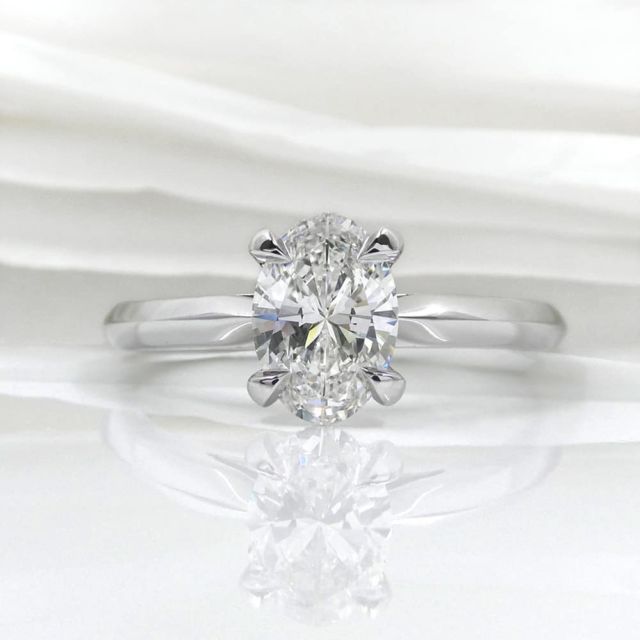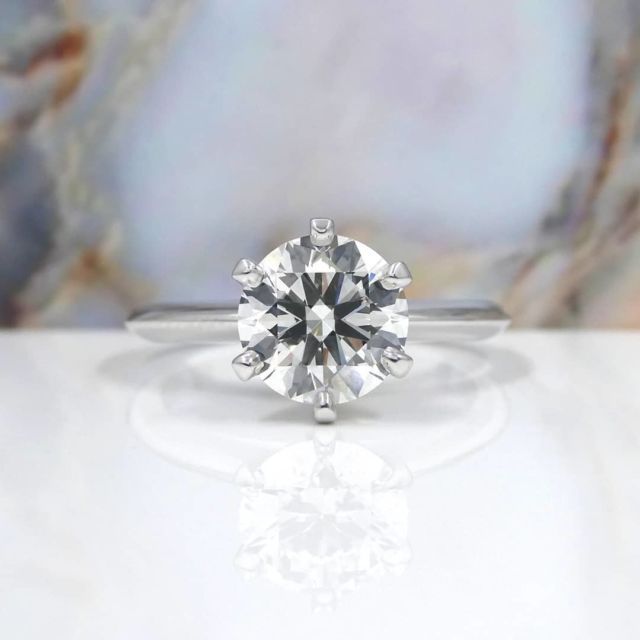Sara Cumming is the Jewelry Production and Social Media Coordinator at Kimberfire – a brilliant way to buy diamond engagement rings, fine diamond jewelry, and loose diamonds in Toronto, ON and across Canada. She holds a Bachelor of Fine Art from York University and a Diploma in Jewelry Arts from George Brown College. She is skilled in jewelry design using CAD software, as well as traditional goldsmith techniques. When she is not immersing herself in all things jewelry, Sara is a dog mom to Barley, her beagle mix rescue dog who loves a good tummy rub.
Natural Diamonds, Diamond Simulants and Synthetic Diamonds

Diamonds are the most well-known and popular gemstone, desired for their colourless appearance, hardness and fiery brilliance. The diamond is often the first choice for an engagement ring, as its durability and strength symbolize a lasting union. People who are in the market to buy a diamond usually learn about the 4 Cs – a grading system which experts use to determine a diamond’s quality. By evaluating the Cut, Clarity, Colour and Carat, a diamond can be given a grade and priced accordingly. These 4 Cs are very important for the diamond buyer to be aware of to ensure they get a fair price. There are some other terms which may be encountered when buying diamond jewellery that are also very important for the buyer to know. The terms “Diamond Simulant” or “Synthetic Diamond” are relevant in the jewellery business, but little known to the public. We are going to explore these terms, and what they mean, to better educate those who are interested in buying a diamond.
Natural Diamonds
Natural Diamonds are diamonds that were naturally created within the earth, with no human intervention. Diamonds need very specific conditions to form and there are two places in the earth where this is possible – the earth’s mantle below the continental plates and at the site of a meteor impact. Diamonds are composed of the element carbon that has been exposed to extremely high temperatures and extremely high pressure. Natural diamonds are between 1 to 3.3 billion years old. Diamonds are carried to the earth’s surface by deep volcanic eruptions which create pipes in the earth that are filled with magma. The magma carries the diamonds upwards as it flows and cools into igneous rocks called kimberlite. The diamonds are discovered through mining the earth to reach the kimberlite layer, or from this layer being naturally eroded over millions of years and depositing near water sources. Although rare, scientists have also found deposits of small diamonds at meteor impact sites where the diamonds were formed under the heat and pressure of the impact. Diamonds are the hardest natural material found on earth, and when they are cut into gem shapes they maintain their polish and facets better than any other gemstone.
Diamond Simulants
Diamond Simulants are materials which have gemological characteristics similar to a diamond, but they do not share the same chemical structure. A simulant may be artificial, natural, or a combination of the two. The most common diamond simulants used in jewellery are cubic zirconia, moissanite, and high-leaded glass, or rhinestones, which are usually only found in fashion jewellery.
Cubic zirconia (CZ) is a cubic crystalline form of zirconium dioxide that has been commercially produced since 1976. Cubic zirconia is optically flawless, usually colourless, and displays a nice brilliance. It is not as hard as a diamond, so it is less durable and more prone to scratching. It is very easy for a diamond expert to tell the difference between diamond and cubic zirconia using a magnifying loupe. CZs are inexpensive to create and therefore cost a fraction of what a real diamond costs. You may also encounter diamond-coated cubic zirconia being sold in jewellery. A chemical vapour deposition (CVD) process is used to deposit a thin film of polycrystalline diamond onto a cubic zirconia core. This increases the material’s hardness, loss of luster through wear, and imitates a diamonds dispersion. This process should not significantly increase the cost of the CZ.
Moissanite was discovered in 1893 by Henri Moissan (where it got its name) in a meteor crater in Arizona. At first he thought he had discovered diamonds but later he identified them as silicon carbide. Naturally occurring silicon carbide is extremely rare and all forms of it found today are created in a laboratory. The company Charles and Colvard was the first to create and manufacture the moissanite gemstone, which entered the jewellery market in 1998. Classic moissanite has a slight gray, yellow or green hue which is especially noticeable in sunlight. Charles and Colvard have come out with newer lines of moissanite which come closer to the colourless look of diamond. Moissanite is quite strong and durable for everyday wear, however it is not as hard as diamond. Moissanite displays strong brilliance but it is different than that of diamond, in that it exhibits rainbow flashes that can have a “disco ball” effect. Moissanite costs significantly less than diamond of the same size and weight. A diamond expert is able to determine if a stone is moissanite or diamond.
Synthetic Diamonds
Synthetic diamonds are produced in an artificial process, such as a laboratory, rather than a geological process. A synthetic diamond is the same material as a natural diamond – pure crystallized carbon. Since the discovery that diamonds were made of pure carbon in 1797, scientists have been looking for a way to convert it into diamond. There are two ways that synthetic diamonds are created, by HPHT and CVD methods. HPHT stands for High Pressure High Temperature, which is mimicking the way a natural diamond would be formed in the earth. This process places a carbon source, a small diamond “seed” and a metallic solvent in a large press which is then placed under extreme pressure and high temperatures to produce a diamond. These machines are extremely expensive and the process must be very carefully controlled. The other process is by CVD, or chemical vapour deposition, in which a diamond seed is planted into a chamber which is then exposed to a gas, such as methane. The gas is then activated and broken down by microwaves which causes the carbon atoms to accumulate on the diamond seed. Traditionally these processes have had difficulty creating colourless diamonds. HPHT was more commonly used for creating synthetic fancy coloured diamonds, as doping the process with nitrogen or boron would create a coloured diamond. CVD often produces brown diamonds, which are then HPHT treated to remove the colour. However, the companies that create these diamonds are becoming more advanced all the time, and are frequently making large and colourless diamonds. These diamonds sell for 20-30% less than a natural diamond and should always be disclosed to the buyer. To determine whether a diamond is natural or synthetic a diamond expert would use various gemological equipment to determine its origin.
Decision Time
Knowing the difference between natural, simulant and synthetic diamonds helps the buyer make an educated decision. The main reasons people are interested in buying simulants or synthetics is that they cost less than a natural diamond, and the fact that they are created in a laboratory means less environmental impact and an absolute certainty that they are conflict free. People who are looking to buy natural diamonds also do so for different reasons. Some people are looking for something that will be an investment or hold its value over time. Other people are drawn to the traditional idea of the diamond as a symbol of love and strength. I am personally drawn to the natural diamond as a symbol of something that has endured over billions of years and is still strong and beautiful.
About Kimberfire
A brilliant way to buy high-quality custom engagement rings, diamonds, and jewelry. Discover expert guidance, complete transparency, and unmatched value in Toronto and across Canada.
Share this entry
Leave a Reply
Want to join the discussion?
Feel free to contribute!







